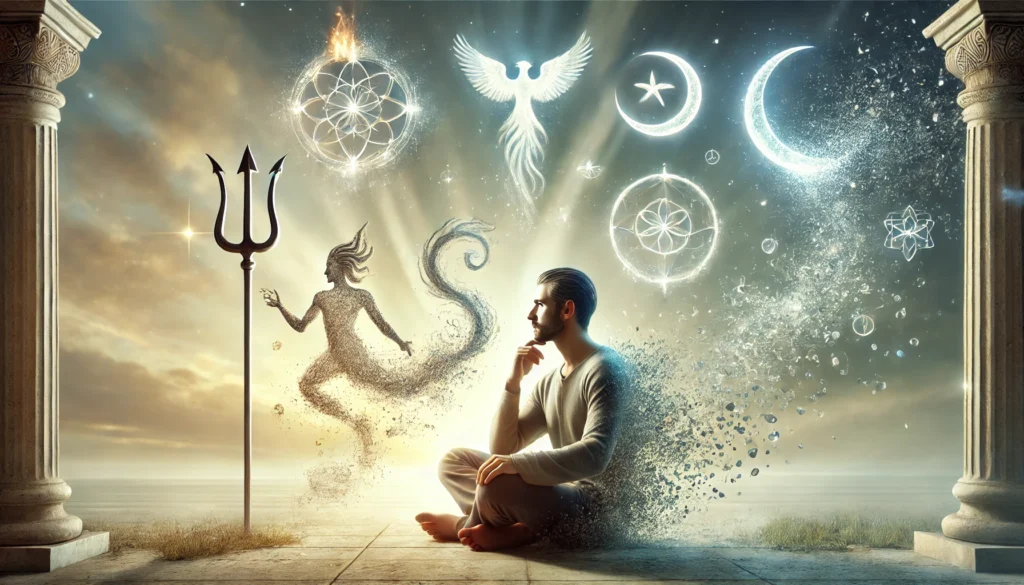Clairsentient Empath: Signs You’re Spiritually Gifted

Clairsentient empathy involves sensing subtle energies and emotional waves on a deeper level than standard empathy. This topic connects to many intuitive gifts, which gain further context in Intuitive Empath Secrets to Understanding Your Gift and Opposite of Empath Traits That Define Narcissistic Behaviors. Both discussions highlight different perspectives on empathy and emotional awareness, laying the groundwork for a richer understanding of what it means to be spiritually gifted in this special way. The exploration below will focus on the clairsentient empath experience, covering key signs, practical techniques, and growth methods for anyone who might sense energies that others rarely perceive.

1. Understanding the Concept
Clairsentient empathy sits under the umbrella of intuitive abilities. The word “empath” suggests strong emotional perception, while “clairsentience” indicates an additional layer of subtle energy sensing. People with this ability often detect emotional vibrations in a way that can feel physical, such as tingles on the skin or a shift in mood that appears to come from external sources. This experience can be both fascinating and overwhelming. Some embrace it right away. Others need time to adjust.
A good starting point is to recognize that clairsentience isn’t a random quirk. It can be part of a broader psychic sense, where an individual picks up intangible signals that reveal truths about environments or people. Whether these truths involve tension, excitement, sorrow, or joy, the body tends to register them as feelings that are not always easy to explain. Yet, this sense can become a valuable tool for personal growth when guided by knowledge and proper coping techniques.
2. Clairsentient Empath Meaning
The phrase clairsentient refers to a type of spiritual perception that revolves around feeling. The term comes from French, where “clair” stands for “clear” and “sentience” deals with sensing. In simple language, clairsentient perception means receiving extra data through emotional or bodily impressions, not just mental reasoning.
Many with strong clairsentience encounter these feelings as physical sensations, like chill bumps or sudden warmth. Others pick up on subtle mood shifts in groups. A popular description of this gift is the “clear feeling” phenomenon, where insight appears without logical clues. Emotions, tensions, or calm vibes can be sensed in the air.
Embracing the clairsentient meaning can help individuals grasp the deeper layers behind their everyday reactions. Instead of dismissing these gut instincts, they can see them as messages. Over time, recognizing and decoding these cues can lead to more empathetic interactions. It can also spark a desire to help others understand their own experiences.

3. Clairsentient Empath Definition
A clairsentient definition highlights the capacity to receive non-verbal signals through physical and emotional sensations. It goes beyond basic empathy. While many people have empathy, a clairsentient may feel the environment itself as though it has an emotional texture. For instance, walking into a silent, empty church might trigger a deep sense of peace or solemnity, even if there’s no obvious cue explaining why.
Some see clairsentience as a sixth sense because it adds clarity about hidden vibrations. This awareness might include:
- Noticing a slight pressure in the head around specific people
- Feeling a sudden heaviness in the chest when walking into certain buildings
- Experiencing random waves of emotion that match what someone nearby is feeling
The ability can extend to sensing energies tied to objects. Holding a family heirloom might evoke fondness or unease, depending on its history. The person who experiences this is picking up the lingering emotional fingerprint left by past owners. While these impressions can seem mysterious, they are often consistent once someone learns to pay attention.

4. What Is a Clairsentient Empath?
What is a clairsentient empath? This phrase describes someone who merges the traits of an empath with the heightened feeling sense of a clairsentient. Empaths already sense the feelings of others, often taking them on as if they were their own. Yet, clairsentient empaths have a sharper sensitivity that includes physical cues, energetic undercurrents, and atmospheric changes.
A clairsentient empath may not only feel a person’s sadness but also sense a tightness in their own chest. Subtle vibrations often become evident, hinting that something is off before anyone speaks. Upon entering a room, they can detect echoes of past events or unvoiced tension. Such extra details can be both a gift and a challenge.
Many clairsentient empaths find they’ve been this way since childhood. They recall experiences like crying uncontrollably for reasons they couldn’t name or feeling drained around certain people. Over time, they might learn to shield themselves or ignore the feelings. Yet, once they understand the clairsentient aspect, it becomes clear that these impressions hold meaning and can even guide decisions in life.

5. Early Indicators of Clairsentient Empathy
Early indicators vary, but they often share common threads. Some individuals sense a drop in temperature, even when the room is warm, whenever someone with heavy emotions enters. Others note that their moods change rapidly in crowded places, as if they’re tuning into multiple emotional stations at once. These episodes might stand out more in busy malls, airports, or anywhere people converge.
Key signs include:
- Goosebumps or Tingling: Sudden shivers when encountering strong emotional events.
- Random Emotional Shifts: Feelings of sadness, excitement, or anxiety that have no personal trigger.
- Physical Reactions to Others: Odd aches or pains that match someone else’s discomfort.
- Needing More Alone Time: A strong urge to retreat after social gatherings, due to emotional fatigue.
- Unexplained Sensations: Subtle internal cues that warn of a conflict or hint at hidden truths.
These initial signs can be disorienting. Individuals may doubt themselves, thinking they’re overreacting. Yet repeated experiences often confirm that these sensations aren’t random. Recognizing them is the first major step to embracing a clairsentient empath path.

6. What Is the Difference Between an Empath and a Clairsentient Empath?
A frequent question is, what is the difference between an empath and a clairsentient? An empath primarily experiences other people’s emotions as though they were their own. This is still a deep form of sensitivity. On the other hand, a clairsentient person perceives subtle energies on top of standard empathy, often manifesting as physical sensations or intuitive hits that go beyond direct emotions.
- Empath: Feels and absorbs others’ emotions. Recognizes these emotions in themselves.
- Clairsentient: Senses both emotions and subtle energetic or spiritual signals through bodily and emotional cues.
When both abilities combine, the result can be intense. The clairsentient empath can sense unspoken tensions, soak up emotional waves, and feel them physically. This blend is sometimes overwhelming, but with proper grounding, it can offer profound awareness of relational dynamics and environmental energies.

7. Clairsentient Empath: Daily Signs and Real-Life Examples
A clairsentient empath’s day is sprinkled with small validations that their gift is active. For example, someone might be washing dishes and suddenly feel an unexplainable anxiety. Minutes later, a friend calls, upset about a crisis. Or, while walking through a store, a wave of sadness can appear out of nowhere, only to notice a stranger nearby crying softly in a corner.
Daily life scenarios include:
- Morning Wake-Up: Waking up feeling low or restless, then hearing about a family member’s argument that took place nearby.
- Workplace Vibes: Picking up tension in the office, sensing arguments brewing before voices are raised.
- Social Situations: Feeling drained after a party, even if the event seemed fine on the surface, due to soaking in multiple energy streams.
- Random Encounters: Meeting someone new and sensing their genuine or false nature based on a fluttery or heavy feeling in the body.
Such moments confirm that this heightened sensitivity is real. By noting these experiences in a journal, clairsentient empaths can track patterns, identify triggers, and learn how their bodies respond to different emotional climates.
8. Challenges of a Clairsentient Empath
While a clairsentient empath has special insights, these come with challenges. The biggest is emotional overload. Because the mind and body are constantly scanning the environment, they absorb more data than a typical person might. This can lead to:
- Chronic Fatigue: Feeling tired all the time, especially after large gatherings or intense emotional exchanges.
- Mood Swings: The struggle to differentiate personal feelings from the emotional energy of others.
- Anxiety in Crowds: The merging of many emotional frequencies at once can be overwhelming.
- Physical Discomfort: Stomach knots, headaches, or muscle tension from absorbing stress.
Another challenge is the social misunderstanding that can arise. Friends or relatives might view the clairsentient empath as too sensitive. Skeptics may accuse them of seeking attention. Over time, these responses can create loneliness or self-doubt. This is why it’s vital for clairsentient empaths to find communities or resources that validate their experiences.

9. Emotional Overload and Self-Protection
Emotional overload happens when the empathic antenna picks up so many signals that the mind and body can’t process them quickly. It can feel like trying to listen to dozens of radio stations at the same time. That mental static causes stress and confusion.
Self-protection techniques are essential. Consider:
- Mindful Breathing: Slow, steady breaths lower adrenaline levels triggered by intense emotional waves.
- Protective Visualization: Imagining a shielding bubble or light around the body, blocking non-helpful energy.
- Quiet Retreats: Spending a few minutes alone in a calm place to reset.
- Intentional Engagement: Limiting time with people who consistently drain energy, known as energy vampires.
Using these methods consistently can minimize the risk of being overwhelmed. It’s a matter of developing a daily routine that acknowledges this high sensitivity, rather than ignoring it.

10. Practical Grounding Techniques
Grounding techniques help a clairsentient empath remain steady. Grounding means connecting firmly to the body and surroundings, so external energies don’t dominate. Useful practices include:
- Earthing: Placing bare feet on natural ground—grass, soil, sand—to feel the Earth’s supportive energy.
- Body Check-Ins: Doing quick scans of the body to notice where tension is stored and releasing it with slow exhales.
- Physical Activities: Yoga, gentle stretches, or walking to discharge pent-up energy.
- Breath Counting: Inhale for a count of four, hold briefly, then exhale for four. Repeating this cycle brings focus to the present moment.
These methods might sound simple, but they can be a lifeline during high-stress moments. The body’s link to the Earth is a strong anchor that helps filter emotional waves. Over time, grounding becomes second nature, and clairsentient empaths can navigate busy or tense environments with less strain.

11. Importance of Energy Boundaries
Boundaries aren’t just about saying “no” in a social sense. Energy boundaries refer to an internal decision about which feelings to allow in. Setting these boundaries helps a clairsentient empath avoid unconsciously carrying everyone else’s emotional burdens.
Simple boundary methods include:
- Mental Affirmations: Saying, “I release what isn’t mine,” or “I choose only energies that serve my highest good.”
- Delayed Response: If someone is venting, pause before absorbing. This small mental gap can prevent automatic merging with another person’s sadness or anger.
- Physical Cues: Positioning the body slightly turned away or crossing arms lightly if feeling overwhelmed by another person’s emotional intensity (in a polite way that still respects the conversation).
- Exit Plans: Knowing it’s okay to step outside during intense group interactions, returning only when feeling balanced.
The goal is not to shut down empathy but to use it in a healthy, controlled manner. Boundaries protect the clairsentient empath from emotional fatigue while still allowing them to offer genuine compassion.

12. Clairsentient Empath in Relationships
Relationships can feel especially deep for clairsentient empaths. They pick up on unsaid worries, hidden resentments, or unspoken hopes. While this can foster closeness and understanding, it can also create complications. When someone’s partner or friend is stressed, the clairsentient empath may feel it in their own body, leading to confusion about who owns the emotion.
Communication is key. Explaining these heightened perceptions to loved ones can prevent misinterpretations. Partners should know that a clairsentient empath might need alone time after arguments or big events. Friends might need to understand why certain crowded gatherings are draining. When people around the clairsentient empath see that these needs are genuine, they are more likely to be supportive.
On the flip side, clairsentient empaths often excel at being supportive listeners. Their ability to sense the deeper undertones of a problem can help them provide empathetic advice. Yet, healthy boundaries remain crucial, or they risk carrying everyone’s emotional load on a daily basis.

13. Reading Energy Through Physical Sensations
Clairsentient empaths frequently refer to reading energy like reading a book. These signals show up as physical cues that correlate with the emotional temperature around them. A few examples are:
- Skin Prickles: Small tingles on the arms or back of the neck when encountering strong emotional fields.
- Heart Flutters: A jumpy or fluttery feeling in the chest when near excitement or love.
- Heavy Limbs: Weighted arms or legs in the presence of anger or hostility.
- Heat or Cold Surges: Sudden temperature changes in the body that reflect emotional tension in a space.
Learning to differentiate these signals from personal emotions is a big part of mastering clairsentience. Journaling or mental notes can help, as can comparing one’s initial physical impression with later confirmations—like someone revealing their strong emotions afterward.

14. Noticing Environmental Shifts
Environments hold residue from past events. A clairsentient empath might feel uneasy in an old house with a grim past or sense serenity in a garden where someone once experienced great joy. These feelings can be subtle or strong, depending on how sensitive the empath is and how intense the events were.
It helps to approach new places with awareness. Slowly scan the environment upon entering:
- Is the air tense or light?
- Does the body register any tingles or pressure?
- Are there random emotional waves, such as sadness or relief, that appear out of nowhere?
Over time, noticing these shifts becomes natural. A quiet sense of knowing develops, guiding the clairsentient empath on how to move through different spaces. If a location feels too heavy, it may be wise to limit time spent there or employ grounding techniques to avoid lingering negative energy.

15. Self-Care Rituals
Self-care is vital. Frequent exposure to emotional currents can wear down even the most experienced clairsentient empath. Regular self-care habits nourish resilience and prevent burnout. Some routine suggestions include:
- Salt Baths: Adding sea salt or Epsom salt to a warm bath can cleanse the aura.
- Aromatherapy: Diffusing lavender or chamomile essential oils for relaxation.
- Simple Meditation: Sitting comfortably, focusing on the breath, and letting thoughts pass without judgment.
- Gentle Movement: Activities like stretching or a leisurely walk help shake off stagnant energy.
- Creative Outlets: Painting, writing, or playing music can channel excess emotional energy into artistic expression.
These rituals serve as check-in points. They prompt a clairsentient empath to pause and confirm whether they’re carrying outside emotions or processing personal ones. Over time, daily self-care fosters a sense of calm and control.

16. Spiritual Growth Path
Clairsentient empathy often dovetails with a spiritual path. Being open to invisible energies can pave the way for deeper explorations, like learning about chakras, engaging in energy healing, or developing a meditation practice. Some individuals discover that their clairsentience aligns with other intuitive abilities, like clairvoyance (clear seeing) or clairaudience (clear hearing).
This growth doesn’t need to follow a rigid system. Each clairsentient empath can explore spiritual themes at their own pace. The process might involve:
- Reading books about energy work
- Attending workshops or retreats
- Meeting with mentors experienced in intuitive arts
- Trying out guided meditations or group circles
The core idea is to stay curious. Embracing spiritual growth should feel supportive, not forced. Regular reflection on how these explorations make one feel ensures that each step aligns with personal authenticity.

17. Recognizing Toxic Energies
Toxic energies are those that deplete, harm, or create stress. Recognizing these energies early on helps a clairsentient empath avoid unpleasant fallout. Common signs include:
- Tight Chest or Throat: A choking sensation indicating hostility or negative intent.
- Sudden Dizziness: Feeling off-balance around someone who carries toxic anger or deception.
- Compulsive Need to Exit: A strong urge to leave a room, linked to an overload of harsh energy.
- Irritability: Becoming uncharacteristically short-tempered for no obvious reason.
Sometimes these signals come from a single person. Other times, they stem from group dynamics. Observing the pattern and trusting the first impressions are key. If the body screams “Danger!” it’s wise to listen, even if nothing dramatic is happening on the surface. Removing oneself from that energy or using protective strategies can prevent emotional damage.

18. Grounding at Work for Clairsentient Empaths
Work can be tricky for a clairsentient empath. Offices often hold multiple emotional currents—pressure over deadlines, social tension between coworkers, and personal stress carried from home. Balancing these energies while trying to remain professional is a challenge.
Helpful tips:
- Set Intentions Each Morning: Before starting the workday, affirm internal safety: “I am centered and protected.”
- Take Micro-Breaks: Short pauses to breathe or stretch at a desk.
- Use Calming Objects: Keeping a soothing stone, like a small piece of amethyst, can help re-center during tense moments.
- Establish Boundaries with Colleagues: Gently but firmly decline to absorb constant venting sessions, if they become too draining.
These small choices create a buffer. They help ensure that the empath’s own emotional state remains steady instead of fluctuating all day long.

19. Balancing Logic and Intuition
Clairsentient empaths sometimes wrestle with how to blend their intuitive sense with practical, logical thinking. They might wonder if feeling is trustworthy or if it will lead them astray. Yet, logic and intuition can be allies, not opposites.
A balanced approach could look like:
- Listen to the Initial Feeling: If the body warns of danger or signals that something is positive, note it.
- Gather Facts: Ask questions, research, or speak with others to confirm or clarify.
- Compare Both Sides: Weigh the intuitive impression against data.
- Decide with Confidence: Finalize the choice with an open heart, trusting that both logic and intuition have contributed.
This harmony allows a clairsentient empath to make well-rounded decisions. It prevents overreliance on pure emotion or pure rationality. Such synergy can become a unique asset in career, relationships, and personal choices.

20. Helping Children with Clairsentient Empath Gifts
Some children exhibit signs of clairsentient empathy early on. They may complain about “strange feelings” in certain rooms or display distress when family tensions rise. Supporting these children is crucial. Simple guidance can set them on a constructive path rather than a confusing one.
Consider:
- Validation: Reassure them that it’s okay to feel extra things. They aren’t weird or flawed.
- Calming Activities: Encourage drawing, singing, or quiet play to channel the intense emotions they pick up.
- Basic Shields: Teach them a simple visualization, like imagining a happy bubble around themselves, to block out harsh energy.
- Open Dialogue: Let them share experiences without fear of being dismissed.
When children are taught to embrace their sensitivity gently, they learn coping skills that can carry into adulthood. Early support reduces the chance of them shutting down or fearing their gift.

21. Handling Skeptics and Doubts
Skeptics might react negatively to talk of clairsentience. They may see it as superstition or a psychological issue. While open dialogue can sometimes shift perspectives, it’s wise to set personal limits on debates.
Strategies for dealing with skeptics:
- Keep It Simple: If questioned, offer a brief explanation without trying to prove anything.
- Provide Anecdotal Proof: Share a consistent pattern that’s happened many times, but do so calmly.
- Exit Politely: If someone becomes dismissive or hostile, excuse yourself from the conversation.
- Seek Validating Communities: Look for like-minded circles where discussions about clairsentience are welcomed.
Doubt can also arise internally. That’s natural. Maintaining a log of accurate impressions or times when clairsentient signals proved correct helps reaffirm the gift’s authenticity. Self-trust grows with each validation.

22. What Emotional Vampires Look Like
Emotional vampires feed off others’ emotional or psychic energy. They might seem charming or needy, but their main pattern is to drain rather than energize. A clairsentient empath is often an easy target because of an open, compassionate heart.
Typical behaviors:
- Constant Crisis Mode: They always have an emergency, rarely reciprocating support.
- Blaming Others: They deflect personal accountability, leaving the empath feeling guilty.
- Seeking Drama: They thrive on conflict, so calmer moments feel unfamiliar or boring to them.
- Testing Boundaries: They resist or complain if the empath tries to end or redirect the discussion.
It’s crucial to recognize these patterns. Limiting contact or establishing firm conversation boundaries protects a clairsentient empath from being sapped of energy.

23. Healthy Boundaries at Home
Home should be a safe environment. Yet, living with family or roommates can pose challenges if they regularly share intense emotions. For instance, a sibling who always unloads their work stresses or a partner who bottles up tension until it explodes.
To maintain balance:
- Communicate Needs: Explain that brief alone time is necessary after a long day.
- Designate Zones: If possible, have a personal room or nook for recharging without interruption.
- Agree on Quiet Times: Set a short period each day for silent reflection.
- Limit Media Overload: Avoid constant television or loud music, as these can amplify tension.
These small steps, done consistently, help keep the clairsentient empath from drowning in constant emotional noise. A calm home environment can be a sanctuary, reinforcing the empath’s well-being.
24. Using Clairsentience for Service
Many clairsentient empaths feel a pull to help others. They might pursue counseling, social work, nursing, or holistic healing. Their gift allows them to detect issues lurking beneath the surface. For example, a therapist with clairsentience may sense emotional blocks that clients struggle to articulate.
Using this gift in service means:
- Maintaining Professional Boundaries: Not taking on every client’s pain as personal.
- Charging Fairly (if it’s a service): Understanding that one’s gift is a skill that deserves proper value.
- Regular Self-Cleansing: Ensuring each session ends with a ritual to release absorbed energy.
- Continual Learning: Keeping up with new techniques in empathic or energetic approaches.
Done well, clairsentient service can uplift people in need, while also providing the empath a meaningful career path. It’s a balance of empathy, professional ethics, and good self-care.

25. Tools for Deepening Awareness
Various tools can amplify or organize the clairsentient empath’s abilities. Some prefer simple items like crystals, while others try more structured methods. Examples include:
- Crystals and Stones: Amethyst, black tourmaline, or rose quartz may help with grounding, protection, or heart-opening.
- Aromatherapy: Essential oils like frankincense, bergamot, or ylang-ylang can calm the mind and purify the air.
- Sound Tools: Singing bowls, tuning forks, or soft music can clear dense energies and raise vibrations.
- Energy Healing Methods: Reiki, Qi-based practices, or self-healing rituals can help manage daily energetic load.
Not everyone resonates with each tool. Experimentation is key. The ultimate goal is to find methods that align with personal beliefs and bring consistent relief or empowerment.
26. Meditation Tips
Meditation is a cornerstone of inner balance. For a clairsentient empath, meditation doesn’t have to be a complicated ritual. Even a few minutes can create a major shift in emotional stability.
Basic meditation steps:
- Quiet Space: Sit in a comfortable position, away from loud interruptions.
- Focus on Breath: Breathe in through the nose, hold briefly, and exhale through the mouth.
- Visualize Peace: Imagine a soothing light filling the body, easing any tension.
- Acknowledge Thoughts: Let thoughts pass like clouds without clinging to them.
- Return Gently: After a few minutes, slowly open the eyes and ease back into daily tasks.
This daily practice strengthens the mind’s resilience. It helps a clairsentient empath remain calm despite emotional turbulence, promoting clarity and self-awareness.

27. Practical Journaling Ideas
Journaling helps record insights and spot patterns. A clairsentient empath might keep track of emotional swings, physical cues, or dream impressions.
Some journaling prompts:
- Daily Emotional Scale: Rate mood levels upon waking, midday, and bedtime, noting possible triggers.
- Energy Encounters: Note any strong clairsentient hits, like a sudden surge of sadness or warmth around a certain person.
- Location Sensations: Write about feelings when entering new places, analyzing if they match the environment’s history or vibe.
- Progress Checks: Reflect on coping techniques used that day, such as grounding or shielding, and assess their effectiveness.
Reviewing entries weekly or monthly reveals patterns. It confirms which situations trigger overload and which tools bring relief. Over time, journaling becomes a guidebook for managing and improving clairsentient empathy.

28. Signs of Spiritual Evolution
As a clairsentient empath refines their gift, certain signs of evolution emerge. These can include:
- Greater Emotional Balance: Feeling steadier in crowds or intense settings.
- Improved Intuition Accuracy: Receiving clearer or more precise feelings about people or situations.
- Stronger Sense of Purpose: A deeper clarity on life direction or ways to be of service.
- Fewer Overwhelming Spikes: Reduced instances of random crying or unexplained anger.
- Smoother Social Interactions: Feeling more at ease connecting with others, with less confusion about whose emotions are whose.
These shifts often happen subtly. One day, an empath realizes they handled a previously chaotic event with poise. That is a sign of real progress.
29. Additional “Clair” Abilities
Clairsentience is just one “clair” gift. Others include:
- Clairvoyance (Clear Seeing): Receiving intuitive visions or images.
- Clairaudience (Clear Hearing): Hearing words, sounds, or music internally that relay insight.
- Claircognizance (Clear Knowing): Instantly knowing something without being told.
Sometimes, a clairsentient empath realizes they also have mild clairvoyance or clairaudience. These abilities can complement each other. For instance, a wave of sadness (clairsentience) might come with a mental image of someone’s face (clairvoyance). Honoring each ability in a balanced way expands overall intuitive awareness.

30. Myths and Misconceptions
Myths around clairsentient empathy can discourage people from accepting their gifts. Common misconceptions are:
- “It’s Just Imagination”: Dismissing strong intuitive insights as daydreams.
- “You Must Be Psychic 24/7”: Believing the gift never pauses, which pressures people to always predict events.
- “Only Special People Have It”: Suggesting it’s rare, when many can develop or discover these abilities.
- “It Leads to Isolation”: Fearing social rejection, when in reality, empathic skills can deepen relationships if managed wisely.
Clearing up these myths helps individuals feel safe exploring clairsentience. It’s a natural sensitivity, not a guaranteed path to weirdness or social isolation.

31. Sensitivity vs. Weakness
Sensitivity is sometimes confused with weakness. People might think that feeling so much indicates a lack of resilience. In truth, genuine sensitivity can be a powerful strength. It allows for keen insight, heightened compassion, and a more robust sense of human connection.
A clairsentient empath who learns to navigate emotional waves can use these abilities to support friends, spot hidden problems, and make well-informed life choices. Far from being a weakness, this heightened awareness can lead to emotional intelligence that not everyone possesses. It’s a special form of wisdom that benefits both the empath and those around them, as long as boundaries and self-care are practiced.
32. Clairsentient Empath Affirmations for Support
Affirmations fortify a positive mindset. Simple statements repeated daily can remind a clairsentient empath that their sensitivity is a gift, not a curse.
A few affirmations:
- “I honor my feelings and recognize when they belong to others.”
- “I release energy that isn’t mine to carry.”
- “My intuition guides me toward safety and clarity.”
- “I set firm boundaries without guilt.”
- “My sensitivity is a doorway to deeper understanding.”
Reading or reciting these statements builds inner resilience. They help counter negative self-talk and create a foundation of self-trust.

33. Clairsentient Empath Navigating Group Events
Group events, like concerts, weddings, or conferences, can bombard a clairsentient empath with a wide range of energies. Instead of avoiding all gatherings, one can plan strategically:
- Pre-Event Preparation: Meditate or breathe deeply before arrival, affirming emotional safety.
- Bring an Anchor Item: A small crystal, a calming scent on a handkerchief, or a familiar piece of jewelry.
- Check In Regularly: Slip away to a quiet hallway or outside area for brief resets.
- Plan Exit Strategies: Knowing there’s flexibility to leave early can reduce anxiety.
Navigating group events isn’t about shutting down empathy. It’s about striking a balance so that shared activities remain enjoyable and not emotionally taxing.

34. Clairsentient Empath: Staying Grounded in Everyday Life
Staying grounded is a process, not a single event. It helps to weave small grounding acts into daily life:
- Morning Routine: A quick stretch or short breathing exercise before the day starts.
- Mindful Eating: Noticing flavors, textures, and the body’s reactions to meals.
- Limited Screen Time: Emotional overload can also come from digital media, so setting boundaries around news or social platforms helps.
- Evening Wind-Down: Turning off bright screens, sipping herbal tea, or journaling about the day before bed.
These habits form a safety net. Even on stressful days, a clairsentient empath has touchpoints of calm. This structure fosters a steady emotional baseline, making it easier to handle sudden surges of external feelings.
35. Final Reflections
Clairsentient empathy reveals a hidden dimension of emotions and energies. It’s a gift that enables a deeper sense of connection with people, places, and even objects. Yet, it can also be a source of overwhelm without the right self-care tools. By understanding the clairsentient meaning and clarifying the clairsentient definition, individuals can see this heightened form of empathy in a positive light.
Early signs, like random mood swings or physical chills, often serve as the first clues of emerging clairsentient abilities. Recognizing these signals helps the empath establish practical boundaries and embrace grounding routines that shield them from emotional overload. A strong grasp of what a clairsentient empath is—along with guidance on what is the difference between an empath and a clairsentient—further refines self-awareness. Daily practice, whether through breathing exercises, visualizations, or mindful breaks, transforms these gifts into valuable life skills.
Over time, clairsentient empaths can develop a deep spiritual dimension. Their journey might include exploring additional “clair” abilities or nurturing a personal sense of purpose that aligns with helping others. Myths and misconceptions about this gift can fall away, replaced by recognition of the empath’s ability to sense nuances that enhance understanding. In relationships, at work, or in public gatherings, the empath can thrive by using boundaries, healthy self-expression, and intentional grounding.
Sensitivity is strength. When directed wisely, it opens doors to compassion, meaningful service, and authentic connection. Each clairsentient empath has the right to nurture this quality, letting it become a guiding light in everyday life. Through consistent practice, self-compassion, and supportive networks, clairsentient empathy can flourish. It can be a loving force that informs decisions, nurtures understanding, and fosters kindness in a world that often overlooks the power of feeling.





